Apple Watch Hands-On
by Ryan Smith on March 9, 2015 6:00 PM EST- Posted in
- Wearables
- Apple
- Mobile
- iOS
- Apple Watch
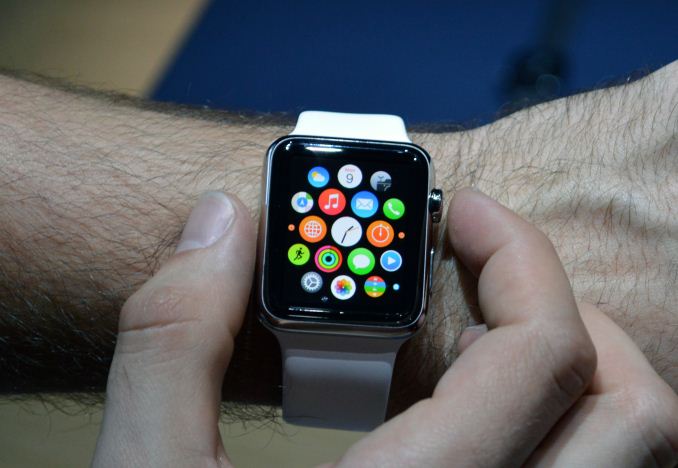
By far the highlight of Apple’s Spring Forward event was the Apple Watch. Though announced back in September, Apple has not allowed any hands-on time with the device until now. So along with finding out the full launch details today, this is the press’s first chance to actually try out what’s the first new product line from Apple in the last half-decade.
As a quick reminder, Apple is selling the watch in 2 sizes, 3 styles per size. The 38mm and 42mm sizes are essentially men’s and women’s sizes, with the 42mm carrying a general price premium of $50; and while Apple doesn’t officially mention it, we know from previous leaks of their developer guidelines that the watches have different resolutions, with the 38mm coming in at 272x340, and the 42mm at 312x390. Meanwhile the 3 oddly named styles of the watch are the entry level Apple Watch Sport, the mid-level suffix-less Apple Watch, and the luxury Apple Watch Edition. Each version of the watch moves up in material, from brushed aluminum, to polished stainless steel, to 18kt gold.
Having a chance to try the Sport edition, I’m still not entirely sure what to make of it. The Apple Watch is essentially a wrist-mounted extension for your iPhone plus a sensor suite. That gives it a lot of flexibility – Apple’s still waiting to see what developers can do with it – but it’s also clearly a first-gen Apple product looking to find its place in the world. Apple has some ideas, but long term it’s going to be developers that make or break it and they are keenly aware of that.
In-hand (or rather on-wrist), the size feels right, at least for someone used to wearing a sizable sports watch in the first place. Though the Sport bands Apple had on-hand did not come in a size-Ryan. Interacting with it is definitely going to be a learned art; the only physical controls are the side button and the crown, so most interaction comes from touch interactions with a fairly small screen. The Apple Watch combines traditional touch gestures with pressure gestures from their new Force Touch technology, so interactions can come from swipes or touches of various pressure.
For today’s hands-on, the apps themselves are more proof of concept than real-world, as they were only setup to run through Apple’s demo material. The Watch offers an interesting selection of apps iPhone-tethered apps, shifting from a second screen for you iPhone to running scaled down versions of iPhone apps. Notifications, emails, etc can all be accessed from the Watch for communication purposes. You can also make calls from the watch, though in the admittedly crowded demo room it seemed to be a poor idea. Other apps included scaled down versions of Uber, and a scaled down version of iTunes for playing music through the Watch.
The other half of the Watch’s applications are focused on “native” functionality. This includes the actual watch face application – selectable and further customizable faces/skins of course – and applications that take advantage of the Watch’s sensor suite. The bulk of the sensor apps focus on fitness in one way or another, and this I suspect is largely due to the fact that the most “novel” sensor on the Watch is the heartrate monitor (otherwise accel/gyro are already on the iPhone). Fitbit, MS Band, and other fitness tracker users should have a good feel for what to do with this, while new users will take some guidance. Though since the interface is almost entirely iconographic, there will be a learning curve for everyone just to learn what the various icons mean and do.
The Watch appears to be running a heavily scaled down version of iOS, and in terms of performance it’s perhaps not surprising that performance feels like it’s yearning for a full Apple A-class SoC at times. Apps other than the clock – which is essentially part of the home screen – have a short but distinct loading time. Once you’re in an app most move smoothly as you’d expect, though flipping through one of the Apple fitness applications saw noticeable stuttering. Whether the load times and stuttering I saw is a limit of the SoC or the NAND I’m unsure, though as this is a pre-release device it’s entirely likely that Apple still has some performance tuning to go. What we’re seeing right now is generally going to be performant enough, but it’s not iPhone 6 level smoothness.
The million dollar (well, $10K+) question right now is this: is it worth it? That’s a question I don’t think a hands-on test in a closed environment can answer. I think it’s going to be a geek product before it goes mainstream – and this has been the case for Apple’s previous mobile products as well – as the novelty is certainly going to help get it off the ground. Whether such a watch is useful as opposed to just taking your iPhone out of your pocket is another matter; more than a few people I know gave up watches because their phone was convenient enough for a time piece, so getting them to buy back into watches is not a given, particularly since the Watch only has very limited functionality without an iPhone by its side to provide it with data (locally you have the sensor based applications, but not much more). Which isn’t to say that I’m for or again the Watch right now, only that I would need to test it at my own pace to figure out if and where it can fit into my life.
Anyhow, the Apple Watch hits retail on April 24th. So we’ll be back next month with a more comprehensive look at Apple’s latest foray into mobile.


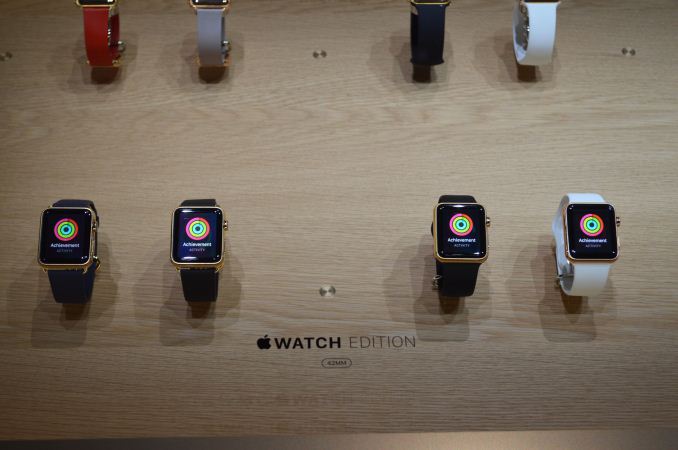
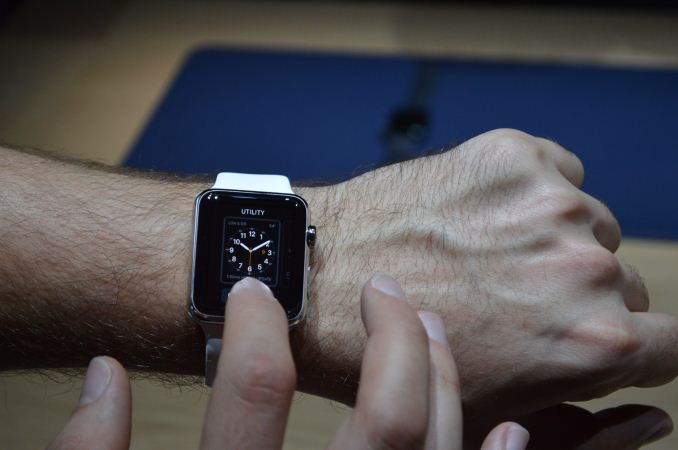
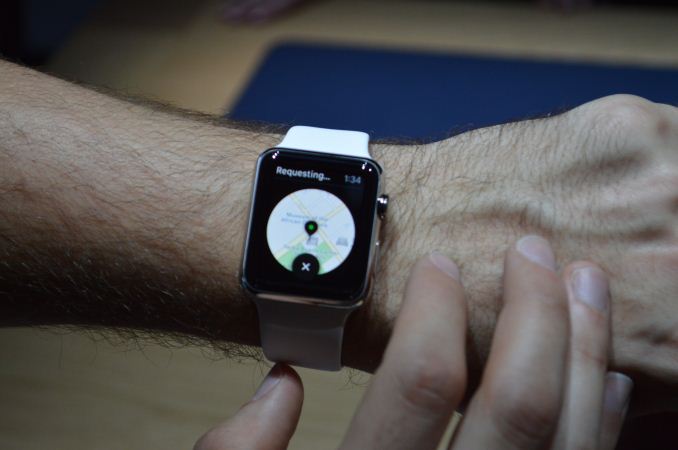
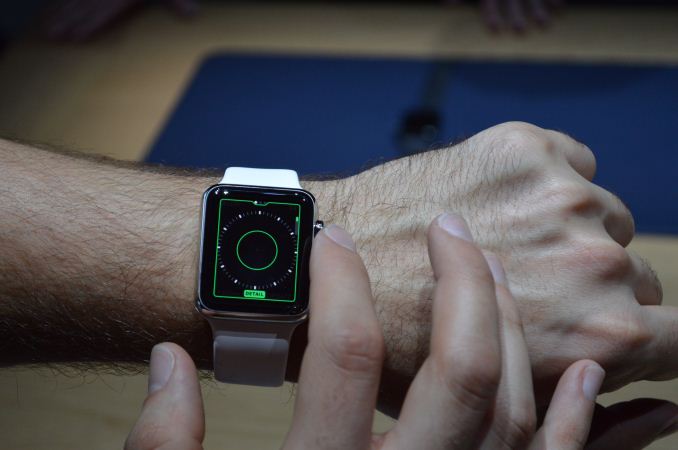
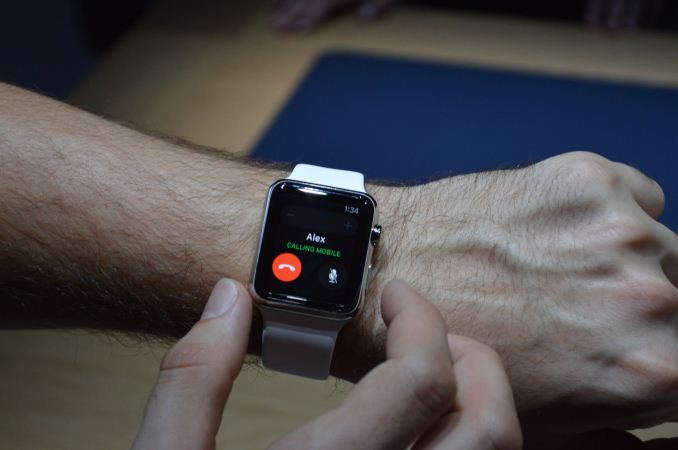
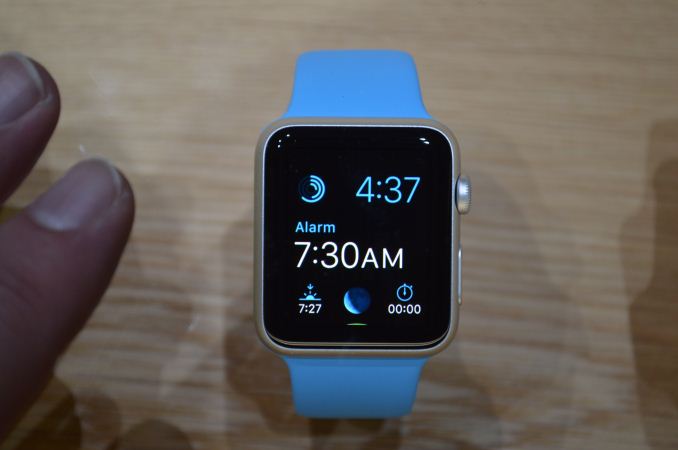








66 Comments
View All Comments
name99 - Tuesday, March 10, 2015 - link
Hmm. I OWN a Pebble. You, apparently, do not."Just as capable"? Sure. If you don't think that Siri, or answering calls on your wrist is important. If you don't care about the "intimacy" features (heartbeat, sending drawings). If you don't think that future OS additions (most likely cross-device authentication) don't matter. If you don't think the ability to customize your watch face and glances don't matter.
I love my Pebble. But let's not pretend it's the same thing as what Apple is offering here. Every one of the features I've listed above is something I actually WANT from my Pebble, but don't have.
(aWatch is not perfect. In particular, if charging is not fast enough to happen while I'm showering, meaning I can't sleep with it, then it can't track my sleep and that will irritate me a LOT.)
I don't know why Apple didn't go with colored ePaper like Pebble, but the arc of history shows that people prioritize rich colors and fast animation a LOT more than seems "rational". Kindle still sells their eInk reader to a few devotees, but the mass market [and that includes me] would far rather read using a Kindle app on their retina iPad Air's, with super fast UI interaction and animation, and put up with once a day charging, than accept the limitations of eInk and once a month charging...
Speedfriend - Tuesday, March 10, 2015 - link
" Kindle still sells their eInk reader to a few devotees, but the mass market [and that includes me] would far rather read using a Kindle app on their retina iPad Air's"I can't remember the last time I saw someone reading something on the tube on an iPad, but I see kindles daily. For that matter, I hardly ever even see people watching movies on an iPad anymore, it is mostly on a phablet.
Reflex - Tuesday, March 10, 2015 - link
The most expensive eInk Kindle on the market, the Kindle Voyage, is still backordered, months after it launched. I think the eInk devices are doing just fine...melgross - Tuesday, March 17, 2015 - link
Actually, they're not. Pebbles are simplistic devices, not even as capable as Android wear. That's why Pebble is coming out with a more sophisticated watch with a completely new OS that obsoletes the current one, though the watch still won't have touch, or a high quality screen.Morawka - Tuesday, March 10, 2015 - link
the 1st gen of anything is always high. 1st gen macbook air was expensive as hell, 1st gen iphone as well. 1st gen ipad.they need to pay for all the initial R&D.
They will eventually get a it down to $199 but it will be a year from now
SirPerro - Tuesday, March 10, 2015 - link
The problem is they cannot afford having a yearly iteration. So 1st gen will last quite long.I guess the guy spending 10K in an apple watch would be QUITE pissed off if it gets obsolete the next year.
Alexey291 - Wednesday, March 11, 2015 - link
Apple can't afford yearly iteration? Say what now?Deelron - Monday, March 9, 2015 - link
A Fitbit surge is $249. It's a very different product, but the differences in technology don't scream "not worth $100 more," at least not for people interested in a product of this type.eanazag - Monday, March 9, 2015 - link
Why not mention 300+ cheeseburgers and a soda?This is a first ten product and will have a lot more things worked out in a gen 2 or 3. It's Apple the product is going to be on the high end. I'm sure they could start a $100 less. We'll see. I don't think there is enough there for me.
I'm not happy about the battery life.
Brakken - Friday, June 5, 2015 - link
10 things that don't strap to your wrist and look good doing it, or add additional functionality. Haha!